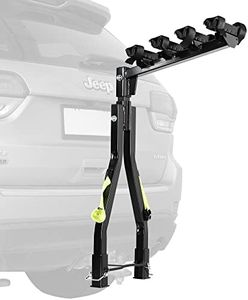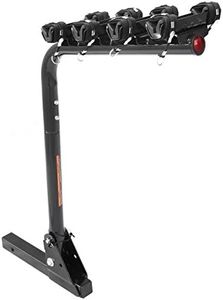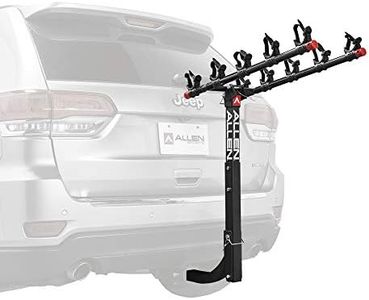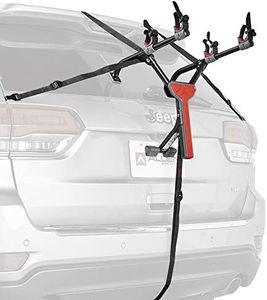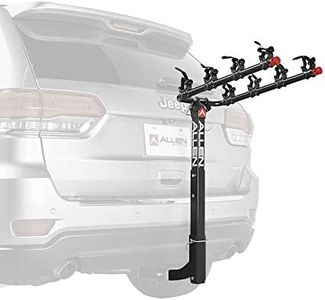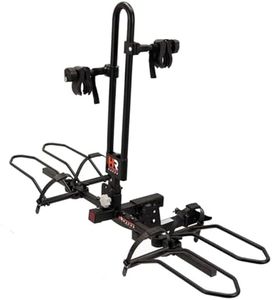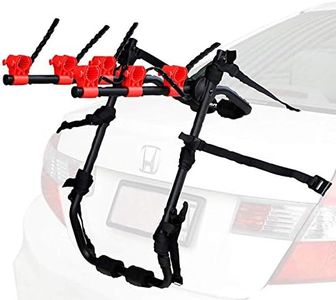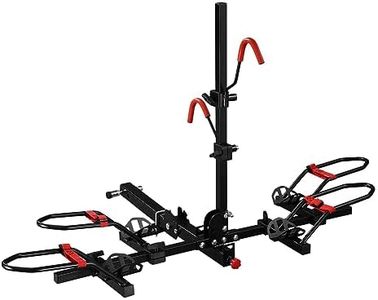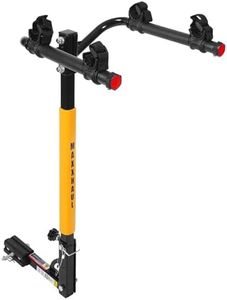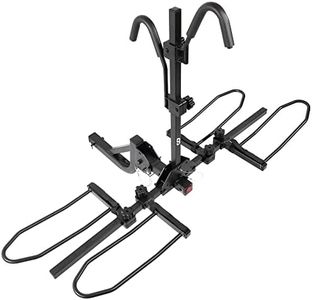We Use CookiesWe use cookies to enhance the security, performance,
functionality and for analytical and promotional activities. By continuing to browse this site you
are agreeing to our privacy policy
10 Best Bike Racks For Cars
From leading brands and best sellers available on the web.By clicking on a link to a third party's website, log data is shared with that third party.
Buying Guide for the Best Bike Racks For Cars
Choosing the right bike rack for your car can seem a bit overwhelming, but a good approach is to focus on how you plan to use it and what fits your vehicle best. Start by considering what types of bikes you will carry, how many bikes you want to transport, and the kind of car you drive. The main goal is to safely and easily get your bikes from place to place, while not making the process of loading and unloading too difficult. Remember to factor in how often you'll use the rack, if you'll need to access your trunk, and whether you value ease of attachment, storage, or long road trip security most highly.Mounting StyleMounting style refers to how the rack attaches to your car, and it is crucial because it affects stability, security, and ease of use. The main types are trunk-mounted, hitch-mounted, and roof-mounted racks. Trunk racks strap onto the rear of most vehicles and are often lightweight and easy to install, making them good for occasional use, but they can sometimes limit trunk access and may not be the most secure for long trips. Hitch racks fit into a hitch receiver and are sturdy and easy to load, ideal for frequent riders and those who transport multiple bikes, but you need to have or install a hitch. Roof racks keep the trunk clear, hold bikes securely, and leave visibility unaffected, but can be harder to load, especially with heavy bikes, and may impact garage access and gas mileage. When picking, consider your car’s compatibility, your physical strength, and how often you'll need to access your trunk or roof.
Bike CapacityBike capacity tells you how many bikes the rack can carry at once, which is important if you often ride alone or with a group. Common capacities range from one to five bikes. Single or double racks are great for individuals or couples, while larger racks suit families or group riders. Be aware that the more bikes you load, the more weight and balance become important, so a high-capacity rack usually needs to be more robust and may be heavier or require a hitch with a higher weight rating. Choose according to the number of bikes you’ll regularly transport; don’t overbuy if you rarely carry more than one or two.
Bike Attachment MethodThis refers to how the rack holds your bikes, and it matters for both security and to prevent damage. There are frame-holding racks, which support the bike by its frame, and wheel-holding racks, which cradle the wheels. Frame-holding racks are often simpler and work with most bikes, but may risk scratching the bike’s finish or not fit unusual frame shapes like some women’s or kids’ bikes. Wheel-holding racks keep the bike more stable and avoid touching the frame, great for carbon frames or odd shapes, but often cost more. Think about your bikes’ frame styles and materials when deciding: the right attachment will keep them safe and scratch-free.
Security FeaturesSecurity features are systems that lock the bikes onto the rack and the rack to your car, important for preventing theft while your car is unattended. Some racks include built-in locks, while others require you to buy extra cables or locks. Hitch and roof racks often have more advanced integrated locks than trunk racks. If you leave your car and bikes unattended, prioritize racks with sturdy lock systems or ones that allow you to add aftermarket locks. For occasional city parking, simple locks may suffice, but for urban areas or overnight stops, the best security is worth the investment.
Ease of Installation and UseEase of installation and use refers to how simple it is to attach the rack to your car and load the bikes onto it. Some racks require no tools and mount quickly, while others take more effort the first time but become easier with practice. If you plan to take the rack on and off frequently or are not mechanically inclined, pick one that’s lightweight with straightforward straps or clamps. If you plan to leave the rack on your car for long periods, a heavier or more complex installation process might be acceptable. Consider how much lifting and maneuvering you can comfortably do, especially for roof-mounted racks.
Vehicle CompatibilityVehicle compatibility means whether the rack fits your specific car. Some racks are universal, but others are designed for certain car types, like SUVs, sedans, or hatchbacks. Before choosing, check the rack's compatibility list or use the manufacturer's online tool if available. Roof racks, for example, need crossbars, while hitch racks need a hitch receiver. Trunk racks are often more flexible but may not suit all spoiler or trunk shapes. Make sure the rack fits securely without damaging the car, and if in doubt, measure your car or ask for help at the store.
